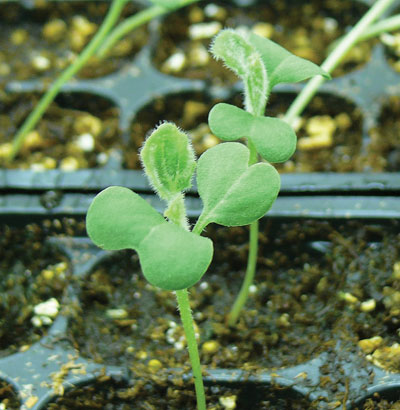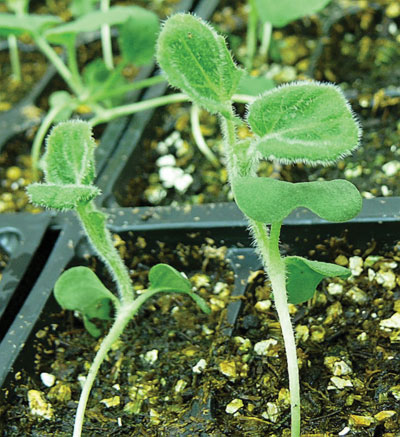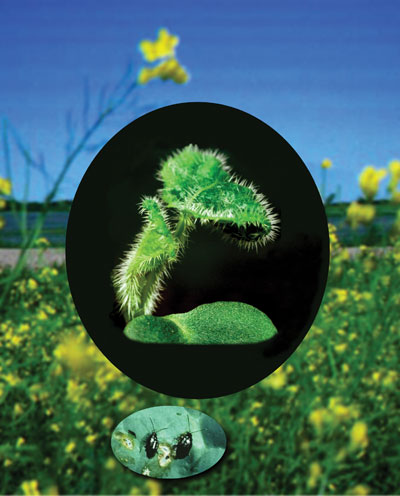
Features
Agronomy
Genetics/Traits
Hairy seedlings stop flea beetles
Flea beetles are one of the most prevalent and economically costly insect pests of the canola industry.
March 18, 2010 By Donna Fleury
Flea beetles are one of the most prevalent and economically costly
insect pests of the canola industry.

|
| Emergence of second true leaf on hairy canola. (Photos courtesy of Agriculture And Agri-Food Canada, Saskatoon Research Centre)
|
Annual losses in North America
from flea beetles, even in non-outbreak years, average more than $200
million. Severe flea beetle feeding at the very early stages of canola
development can result in seedling mortality, delayed maturity and
yield losses. Yield losses of about 10 percent are common where flea
beetles are abundant, even when the crop is protected with insecticides.
The current management strategy for flea beetles is control with
insecticidal seed treatments. “More than 90 percent of the 5.5 million
hectares (13.6 million acres) of canola seeded annually in Canada are
treated, often as an insurance against potential flea beetle damage,”
says Dr. Julie Soroka, research scientist at Agriculture and Agri-Food
Canada’s (AAFC) Saskatoon Research Centre. “We’re currently working on
an exciting non-chemical alternative to reduce the impact of flea
beetles, which would be less damaging economically and environmentally.”
Researchers are working on developing canola plants that could be
resistant to flea beetles. Working with a wild brassica species,
Arabidopsis thaliana, which has a lot of seedling hairs known as
trichomes, researchers introduced two genes from this species into B.
napus (Westar) canola, which is virtually hairless. “The density of the
trichomes on the first three true leaves of the canola plants increased
from fewer than one per square centimetre to over 1000,” explains Dr.
Margaret Gruber, research scientist. “This huge increase in leaf hairs
gives the transformed seedlings a furry, pin-cushion-like appearance.”
The hairy canola plants had trichomes on the true leaves and stems, but not on the cotyledons.
To determine if these hairy canola seedlings had resistance to flea
beetles, researchers compared the hairy and parental lines with
commercial cultivars in the laboratory and the field, starting in 2005.
“The field trials in 2005 and 2006 were very definitive, so in 2007 we
conducted further lab trials to substantiate our findings,” says
Soroka. “The findings clearly show that flea beetles don’t like to feed
on hairy canola.”
They appeared agitated and unsettled, and had difficulty reaching the
surface of the plants. The hairless Westar plants had, on average, more
than twice as many flea beetles on them as did the hairy plants. This
feeding deterrence is the first step in developing crop resistance to
the insect.
 |
|
| Emergence of third true leaf on hairy canola. |
|
 |
|
| Close-up of hairy canola seedling and flea beetles. |
Progress in stages
These preliminary hairy canola seedlings still had no trichomes on
their cotyledons. However, the cotyledons initially seemed to be more
resistant to flea beetles. Later, when the first three true hairy
leaves emerged, the flea beetles seemed to move to the cotyledons to
feed. The plants were larger at this point, so the damage on the
cotyledons from the flea beetles was still much less than on the
traditional Westar plants. Researchers intend to determine if trichomes
on the cotyledons are truly a desirable trait, and then to determine
how to develop plants with hairs on all seedling leaves and the stem.
“The concept itself is pretty exciting, the fact that this is a
physical barrier in the plant, to which it may be difficult for pests
to adapt, as opposed to a mutation causing biochemical resistance,”
explains Soroka. “With resistance based on biochemical traits, the
insect or other organisms may overcome the resistance fairly quickly.”
For example, several leaf rust or greenbug (aphid) biotypes have
overcome resistance in wheat within a few years of the resistance being
developed.
Researchers still have several years of work ahead to develop a
commercially viable hairy canola variety. “The initial crosses we are
working with are not agronomically suitable at this point, with the
plants being quite small and seed almost miniscule,” explains Soroka.
“We need to develop commercial lines that have desirable agronomic and
performance traits along with elevated levels of trichomes on seedlings
that will be resistant to flea beetles.”
Researchers believe this can be successful, and will pursue both
traditional plant breeding strategies and transgenic plant strategies
to develop this new germplasm for farmers.
Next step: research strategies for developing hairy canola varieties
The initial research results have convinced researchers that continuing
work towards developing commercial hairy canola varieties with flea
beetle resistance is a very worthwhile strategy. Therefore, they are
continuing the research on a number of different fronts. “We are
continuing to work with the transgenic plants we originally made, and
will follow the development of their subsequent generations and cross
them with other plants in order to help solve the problem of poor
growth,” explains Gruber. “However, we need a number of different
strategies to solve the growth and agronomic challenges.”
Researchers are studying the genes themselves, with a particular focus
on the components of the DNA that code for enzymes and proteins, which
do the work in making trichomes. “We’re studying one particular region
of the gene that controls, or is the locus, that defines where that
gene is expressed in the plant: in which cell layer, in which tissues,
at what stage of development and under what environmental conditions,”
says Gruber.
To determine that information, a member of Gruber’s laboratory has
hooked that region up to a colour gene, which will act as a reporter of
that information. “These experiments are going on right now and will
take quite a bit of time. However, we will have a much better
understanding of exactly how we need to reconstruct the hair gene
together with this locus of control in order to be able to express the
gene in the right cell layer at the right time.”
This information will be key to solving the problems with plant growth and improving agronomic characteristics.
Researchers are also beginning to study some additional wild species
related to canola that have different hair genes. Gruber says they are
working on obtaining new funding to start an introgression program to
cross the wild germplasm with some of the brassica species and,
hopefully, to drag along the desirable genes. The goal is for the final
plants to look like canola and have canola quality and seed size. “If
possible, we hope to make the final germplasm through these
introgression experiments,” says Gruber. To date, the project has been
a joint venture of AAFC, the Western Grains Research Foundation, the
Saskatchewan Canola Development Commission, the Alberta Canola
Producers Commission and the Manitoba Canola Growers Association.
One other strategy is to isolate new hair genes that have never been
isolated before. “We’re working with our model wild plant, Arabidopsis
thaliana, and screening 50,000 different lines that a colleague
developed in the first stages of our research,” explains Gruber. “We
are interested in finding new regulatory genes for hair development
that may be better than what we have, and to find new forms of
branching genes. We assume that more branching of the trichomes will
create a denser hair mat covering the plant seedlings. This hair mat
will probably provide better flea beetle resistance and will likely
provide better drought resistance as well.”
The project is still very much in a scientific research stage. However,
Gruber says they are learning a lot about the system and believe this
is the first really good trait that has come along for flea beetle
resistance in canola crops. Researchers expect to have commercial
varieties of hairy canola available for growers in the future. The
industry will benefit from reduced economic costs and a much more
environmentally friendly option for flea beetle management.